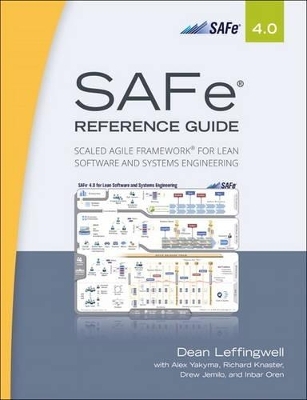
SAFe® 4.0 Reference Guide
Addison-Wesley Educational Publishers Inc (Verlag)
978-0-13-451054-5 (ISBN)
- Titel erscheint in neuer Auflage
- Artikel merken
“There are a lot of methods of scale out there, but the Scaled Agile Framework is the one lighting up the world.”
–Steve Elliot, Founder/CEO AgileCraft
“You don’t have to be perfect to start SAFe because you learn as you go–learning is built in. Before SAFe, I would not know how to help my teams but now I have many tools to enable the teams. My job is really fun and the bottom line is I have never enjoyed my job more!”
–Product Manager, Fortune 500 Enterprise
Captured for the first time in print, the SAFe body of knowledge is now available as a handy desktop reference to help you accomplish your mission of building better software and systems. Inside, you’ll find complete coverage of what has, until now, only been available online at scaledagileframework.com. The SAFe knowledge base was developed from real-world field experience and provides proven success patterns for implementing Lean-Agile software and systems development at enterprise scale. This book provides comprehensive guidance for work at the enterprise Portfolio, Value Stream, Program, and Team levels, including the various roles, activities, and artifacts that constitute the Framework, along with the foundational elements of values, mindset, principles, and practices.
Education & Training Key to Success
The practice of SAFe is spreading rapidly throughout the world. The majority of Fortune 100 U.S. companies have certified SAFe practitioners and consultants, as do an increasing percentage of the Global 1000 enterprises. Case study results–visit scaledagileframework.com/case-studies–typically include:
20—50% increase in productivity
50%+ increases in quality
30—75% faster time to market
Measurable increases in employee engagement and job satisfaction
With results like these, the demand from enterprises seeking SAFe expertise is accelerating at a dramatic rate. Successful implementations may vary in context, but share a common attribute: a workforce well trained and educated in SAFe practices. This book–along with authorized training and certification–will help you understand how to maximize the value of your role within a SAFe organization. The result is greater alignment, visibility, improved performance throughout the enterprise, and ultimately better outcomes for the business.
Dean Leffingwell, creator of SAFe®, is widely recognized as the one of the world’s foremost authorities on Lean-Agile best practices. He is an author, serial entrepreneur, and software systems development methodologist. His two best-selling books, Agile Software Requirements: Lean Requirements Practices for Teams, Programs, and the Enterprise (Addison-Wesley, 2011), and Scaling Software Agility: Best Practices for Large Enterprises (Addison-Wesley, 2007), form much of the basis of modern thinking on Lean-Agile practices and principles.
Preface vii
Acknowledgments ix
Scaled Agile Framework Contributors ix
SAFe Community Contributors x
Additional Acknowledgments x
Introduction to the Scaled Agile Framework (SAFe) 1
Part 1: The SAFe Foundation 9
Lean-Agile Leaders 11
Communities of Practice 17
SAFe Core Values 21
Lean-Agile Mindset 27
SAFe Principles 35
Implementing 1-2-3 37
Part 2: The SAFe Principles 43
#1 – Take an economic view 45
#2 – Apply systems thinking 51
#3 – Assume variability; preserve options 55
#4 – Build incrementally with fast, integrated learning cycles 57
#5 – Base milestones on objective evaluation of working systems 59
#6 – Visualize and limit WIP, reduce batch sizes, and manage queue lengths 61
#7 – Apply cadence, synchronize with cross-domain planning 63
#8 – Unlock the intrinsic motivation of knowledge workers 67
#9 – Decentralize decision-making 71
Part 3: The Team Level 73
Introduction to the Team Level 75
Agile Teams 77
Product Owner 83
Scrum Master 89
ScrumXP 93
Team Kanban 99
Team Backlog 105
Iterations 109
Iteration Planning 113
Iteration Execution 119
Team Demo 125
Iteration Retrospective 129
Stories 133
Iteration Goals 143
Built-In Quality 147
Part 4: The Program Level 153
Introduction to the Program Level 155
Agile Release Train 159
Release Train Engineer and Value Stream Engineer 167
System and Solution Architect/Engineering 171
Product and Solution Management 177
WSJF (Weighted Shortest Job First) 183
Program and Value Stream Kanban 187
Program and Value Stream Backlogs 193
Nonfunctional Requirements 199
Program Increment 207
PI Planning 213
Business Owners 221
PI Objectives 225
System Demo 233
Features and Capabilities 237
Enablers 243
Innovation and Planning Iteration 249
Inspect and Adapt 253
Develop on Cadence, Release Any Time 259
Architectural Runway 265
Part 5: The Spanning Palette 271
DevOps 273
System Team 279
Release Management 283
Shared Services 287
User Experience (UX) 291
Vision 295
Roadmap 301
Metrics 307
Milestones 323
Releases 331
Part 6: The Value Stream Level 337
Introduction to the Value Stream Level 339
Value Stream Coordination 343
Economic Framework 347
Solution Intent 351
Model-Based Systems Engineering 359
Set-Based Design 365
Agile Architecture 371
Solution Demo 379
Pre- and Post-PI Planning 383
Supplier 389
Customer 395
Solution 401
Solution Context 405
Part 7: The Portfolio Level 411
Introduction to the Portfolio Level 413
Enterprise 417
Strategic Themes 423
Program Portfolio Management 429
Epic Owners 435
Enterprise Architect 439
Portfolio Kanban 443
Portfolio Backlog 449
Budgets 453
CapEx and OpEx 463
Value Streams 473
Epics 483
Part 8: Guidance 489
Continuous Integration 491
Test-First 497
Agile Contracts 503
Glossary of SAFe Terms 511
Bibliography 523
Index 529
| Erscheinungsdatum | 02.09.2016 |
|---|---|
| Verlagsort | New Jersey |
| Sprache | englisch |
| Maße | 201 x 254 mm |
| Gewicht | 882 g |
| Themenwelt | Informatik ► Software Entwicklung ► Agile Software Entwicklung |
| ISBN-10 | 0-13-451054-2 / 0134510542 |
| ISBN-13 | 978-0-13-451054-5 / 9780134510545 |
| Zustand | Neuware |
| Haben Sie eine Frage zum Produkt? |
aus dem Bereich



